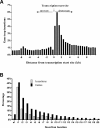Large-scale gene trapping in C57BL/6N mouse embryonic stem cells
- PMID: 18799693
- PMCID: PMC2556270
- DOI: 10.1101/gr.078352.108
Large-scale gene trapping in C57BL/6N mouse embryonic stem cells
Abstract
We report the construction and analysis of a mouse gene trap mutant resource created in the C57BL/6N genetic background containing more than 350,000 sequence-tagged embryonic stem (ES) cell clones. We also demonstrate the ability of these ES cell clones to contribute to the germline and produce knockout mice. Each mutant clone is identified by a genomic sequence tag representing the exact insertion location, allowing accurate prediction of mutagenicity and enabling direct genotyping of mutant alleles. Mutations have been identified in more than 10,000 genes and show a bias toward the first intron. The trapped ES cell lines, which can be requested from the Texas A&M Institute for Genomic Medicine, are readily available to the scientific community.
Figures




References
-
- Abuin A., Holt K.H., Platt K.A., Sands A.T., Zambrowicz B.P., Holt K.H., Platt K.A., Sands A.T., Zambrowicz B.P., Platt K.A., Sands A.T., Zambrowicz B.P., Sands A.T., Zambrowicz B.P., Zambrowicz B.P. Full-speed mammalian genetics: In vivo target validation in the drug discovery process. Trends Biotechnol. 2002;20:36–42. - PubMed
-
- Abuin A., Hansen G.M., Zambrowicz B., Hansen G.M., Zambrowicz B., Zambrowicz B. Gene trap mutagenesis. Handb. Exp. Pharmacol. 2007;2007:129–147. - PubMed
-
- Altschul S.F., Madden T.L., Schaffer A.A., Zhang J., Zhang Z., Miller W., Lipman D.J., Madden T.L., Schaffer A.A., Zhang J., Zhang Z., Miller W., Lipman D.J., Schaffer A.A., Zhang J., Zhang Z., Miller W., Lipman D.J., Zhang J., Zhang Z., Miller W., Lipman D.J., Zhang Z., Miller W., Lipman D.J., Miller W., Lipman D.J., Lipman D.J. Gapped BLAST and PSI-BLAST: A new generation of protein database search programs. Nucleic Acids Res. 1997;25:3389–3402. - PMC - PubMed
-
- Auerbach W., Dunmore J.H., Fairchild-Huntress V., Fang Q., Auerbach A.B., Huszar D., Joyner A.L., Dunmore J.H., Fairchild-Huntress V., Fang Q., Auerbach A.B., Huszar D., Joyner A.L., Fairchild-Huntress V., Fang Q., Auerbach A.B., Huszar D., Joyner A.L., Fang Q., Auerbach A.B., Huszar D., Joyner A.L., Auerbach A.B., Huszar D., Joyner A.L., Huszar D., Joyner A.L., Joyner A.L. Establishment and chimera analysis of 129/SvEv- and C57BL/6-derived mouse embryonic stem cell lines. Biotechniques. 2000;29:1024–1032. - PubMed
-
- Austin C.P., Battey J.F., Bradley A., Bucan M., Capecchi M., Collins F.S., Dove W.F., Duyk G., Dymecki S., Eppig J.T., Battey J.F., Bradley A., Bucan M., Capecchi M., Collins F.S., Dove W.F., Duyk G., Dymecki S., Eppig J.T., Bradley A., Bucan M., Capecchi M., Collins F.S., Dove W.F., Duyk G., Dymecki S., Eppig J.T., Bucan M., Capecchi M., Collins F.S., Dove W.F., Duyk G., Dymecki S., Eppig J.T., Capecchi M., Collins F.S., Dove W.F., Duyk G., Dymecki S., Eppig J.T., Collins F.S., Dove W.F., Duyk G., Dymecki S., Eppig J.T., Dove W.F., Duyk G., Dymecki S., Eppig J.T., Duyk G., Dymecki S., Eppig J.T., Dymecki S., Eppig J.T., Eppig J.T., et al. The knockout mouse project. Nat. Genet. 2004;36:921–924. - PMC - PubMed
MeSH terms
Substances
LinkOut - more resources
Full Text Sources
Other Literature Sources
Molecular Biology Databases
